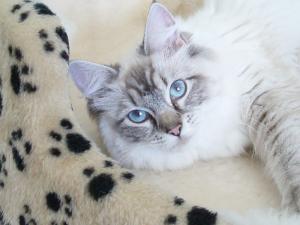


 home
home
 about
about
 kittens
kittens
 queens
queens
 kings
kings
 retirees
retirees
 show results
show results
 contact
contact
What's so special about Ragdolls?
A more loving cat you'll never find. Ragdolls are strictly indoor cats that love and depend upon their owners. In exchange, owners will receive an endless supply of love and affection from their Ragdolls. Many Ragdoll owners have compared their Ragdoll's personality to that of a loyal canine. Ragdolls are eager to interact, and there are numerous accounts of Ragdolls fetching their favorite toy, learning how to shake hands and begging on command.If you want a lap cat, the Ragdoll is for you. Ragdolls need their owner's attention and lots of love. If not on your lap, your Ragdoll will be lying nearby. Very few breeds of cat offer the intimate companionship characteristic of the Ragdoll. Ragdolls are purchased for their purrfect personality. As a bonus, you get a beautiful coat, large, stunning blue eyes, calm laid-back personality, and the classic pointed pattern - all together in one fabulous package called the Ragdoll.
Ragdoll males weigh from six to nine kilograms on average, and females up to five kilograms on average. Ragdolls reach full maturity when they are three to four years of age. Kittens are born white and gradually reach their true colour at approximately two years of age.
Ragdolls do not shed excessively, and need little care to keep their coats in good condition. Their soft, rabbit-like fur does not tend to mat. The fur does require occassional combing or brushing, and the longer fur around the hindquarters should be combed regularly. In general, Ragdolls do not mind being groomed and, in fact, often enjoy the grooming sessions.Is this breed for me?
If you want a large cat which is non-aggressive, loves to be with people, and is very placid, you may want to consider a Ragdoll. Also, if you love the look of a long-haired cat, but do not want the constant grooming associated with breeds such as Persians, a Ragdoll would be a good choice. The gentle Ragdoll is also good with children and is easy to introduce into a multi-pet household.
Do I want a male or female kitten?
Female Ragdoll kittens are as friendly and loving as the Ragdoll males.
Choosing the right sex for your particular circumstances is important.
Ask yourself these questions
- Do I work full time?
- Do I have children?
- Do I have other cats?
- Do I have dogs or other pets?
- Is my home an active household?
- Do you travel and take your pet with you?
If you answer yes to the following questions, then by all means choose a female kitten as your companion.
- Are you a quiet person?
- Do you have a quiet household?
- Do you feel you identify with the female disposition more so than with a male disposition?
Some believe that females make better pets as you don't have to worry about them spraying.
Desexed male cats usually don't spray unless they are unhappy or have some medical issues.
It doesn't matter if you have a male or female, either is liable to spray if home-life isn't happy, or the cat is neglected.
Ragdoll Colours
Seal Point: The Ragdoll body colour should be ranging from ivory to pale fawn beige, shading gradually into a lighter colour on the belly and chest. The points will range from a warm seal brown to a deep brownish black. The paw pads and nose leather to be a seal brown to brownish black, with rosy undertones allowed.
Blue Point: The Ragdoll body should be a bluish white to platinum grey, cold in tone, free of any tinge of brown, shading gradually to lighter colour on the belly and chest. The points will be blue- grey to deep slate. The paw pads and nose leather dark blue. They may have rosy undertones.
Chocolate Point: The Ragdoll body should be ivory, shading gradually to lighter colour on the belly and chest. The points ranging from warm milk chocolate to bittersweet chocolate, all with rose colored undertones. The paw pads should be a brownish salmon pink and nose leather a rose brown.
Lilac Point: The Ragdoll body will be magnolia white. Points a pale dove grey with pinkish tones to a warmer deep lavender, the dilute pigment permitting the flesh tones to show through. Paw pads and nose leather lavender pink.
Red Point: The Ragdoll body should be a warm, even, creamy white. The points will be a deep orange "hot" red. The paw pads and nose leather to be pink.
Cream Point: The Ragdoll body should be creamy white. The points ranging from pale sand to deep cream. The overall impression is dull, cool buff beige. The paw pads and nose leather pink.
Ragdoll Patterns
Colour Point: The points, ears, mask, feet and tail are to be dark with the colour well defined. The body should have definite contrast between it and points. Soft shadings of colour are allowed on the body, as the cat gets older. Nose leather is the colour of the points.
Mitted: The points are to be dark and contrasting to the body, with matching white mitts on the front feet, and white going up the back legs at least to the hock. The chin must be white, and there should be a white belly stripe from the chin down the bib, and running to the base of the tail. This pattern may have a single white blaze between the eyes or a broken blaze between the eyes and on the nose. Blaze may not extend into the nose leather. Nose leather is the colour of the points.
Bi-Colour: The ears, mask and tail to be well-defined in the darker colour. The mask is to have an inverted "V" which should be as symmetrical as possible and should not extend beyond the outer edge of the eye on either side. The nose leather must be pink. The chest, stomach, all four legs, feet and ruff are to be white. The white should reach above the elbow on the front legs, and above the hock on the rear legs. The back may have shading in a lighter shade of the point color, with various markings of white and color patches.
Tabby: Overlays any one of the above patterns. It is actually an additional pattern of stripes appearing over the normal patterns listed above. In addition to the stripes, it has white eyeliner around the eyes, the whisker pads are mostly white, the nose leather is a pinkish to red brick colour and there is no point colour in the ears.
Tortie: Overlays any of the above patterns. Tortie, colour-wise, will generally have red or cream mixed with one of the other colours.
Tortie Tabby: Overlays any of the above patterns. The tortie tabby pattern is a mixture of red or cream with one of the above colours and will also have the tabby markings.
Although lilies are flowers commonly used in floral arrangements, and cats often have access to them, most cat owners and florists, are unaware of lily intoxication as a potential cause of kidney (renal) failure in cats.

Lilies are becoming especially popular as a gift in Australia, and the flowers that are sold are exceedingly toxic to cats. The key to successful treatment of these cats is early recognition of possible ingestion, and aggressive management of the ensuing renal failure. More importantly, prevention is much better than attempted cure, so it is in the interests of cat owners and cat lovers to make the danger of lily ingestion WELL KNOWN in the wider community.
Indoor cats and especially kittens, may be drawn to floral arrangements, as they are a novel feature in an otherwise very familiar environment that often lacks other forms of vegetation. In the course of investigating the flowers, the cats may play with and sometimes chew parts of the plant. This could easily go unnoticed by owners, or may occur while the cat is alone at home. Similarly, cats with access to lilies growing outdoors in domestic gardens may not be observed to contact the plant, so careful questioning regarding the presence of the plant or flowers is always warranted when a vet is investigating kidney failure in cats, especially when it develops suddenly.
The toxic substance in lilies that injures the kidneys has not been identified, but ALL parts of the lily are poisonous - flowers, stamen, stem, leaves and roots. The toxic dose is unknown, but thought to be reached by ingestion of, or mouthing, very small amounts of material.
Cats seem to be unique amongst domestic pets in their susceptibility to this intoxication, possibly due to differences in their metabolism. For the same sort of reason, cats also can be easily poisoned by human medications such as paracetamol, ibuprofen and aspirin, and these too are lethal for cats in doses that would be safe for humans. Interestingly, dogs that consume large amounts of the plant develop only mild gastrointestinal signs, while rats and rabbits show no signs of toxicity at all.
Signs of Lily Poisoning

The first signs of toxicity are vomiting, depression and loss of appetite. The onset is usually within 2 hours, and may subside by 12 hours. Although an affected cat is likely to remain depressed, the patient may appear to improve, briefly (with or without symptomatic treatment) as the gastrointestinal signs abate. It is likely, however, that acute renal failure will develop within 24 to 72 hour at which time the cat will become critically ill. At this time the patient may drink much more than usual, or become extremely dehydrated. Your vet might feel painful, enlarged kidneys on physical examination at this stage. If untreated, cats die in 3 to 7 days.
Diagnosis and Treatment
Your vet can diagnose the presence of acute renal failure using blood tests, urine tests, an ultrasound examination and possibly a needle biopsy of the kidneys. Although there is no specific test that can identify lily intoxication as the cause with certainty, there are characteristic laboratory findings that make the diagnosis likely if supported by evidence of lily ingestion. The treatment for lily intoxication is intensive, typically involving intravenous fluid therapy and hospitalisation for several days.
.resizedto300x225.jpg)

